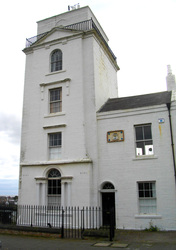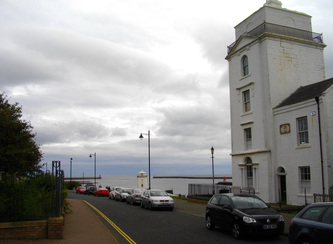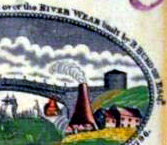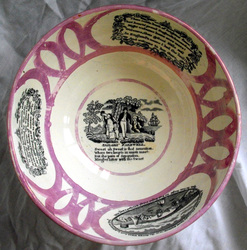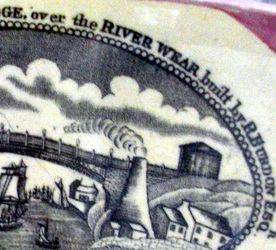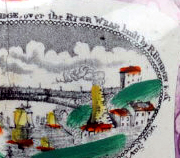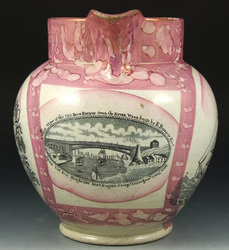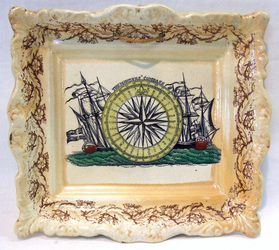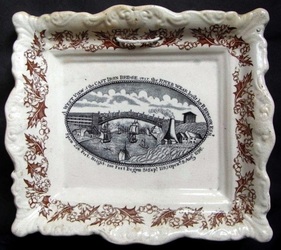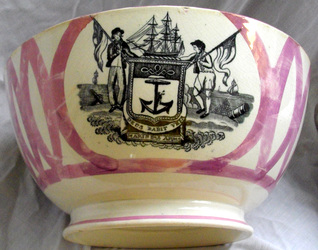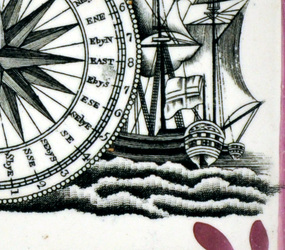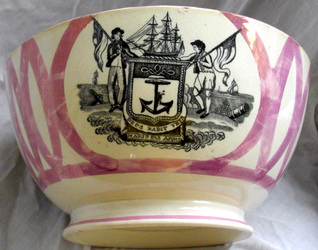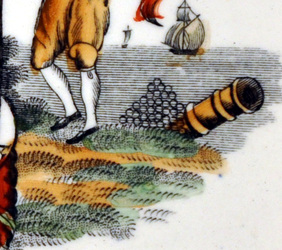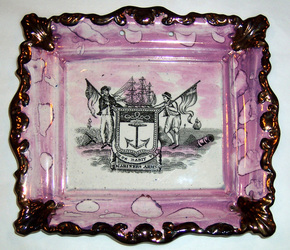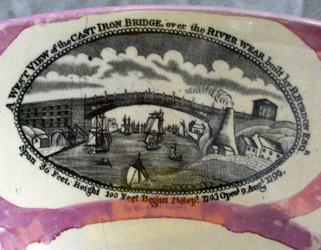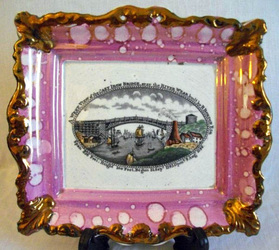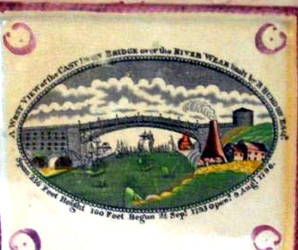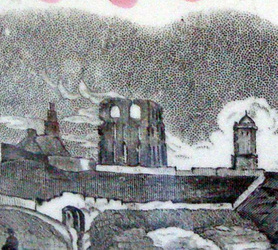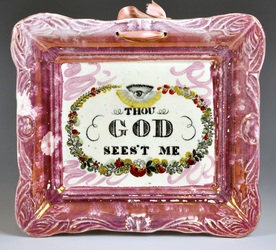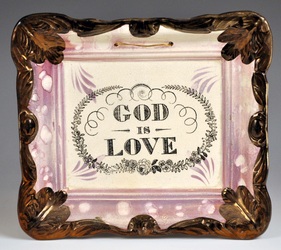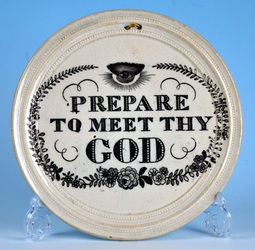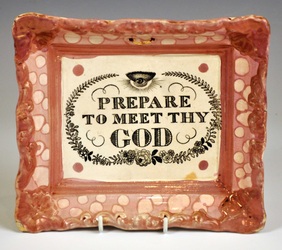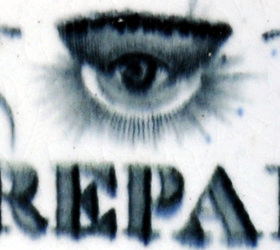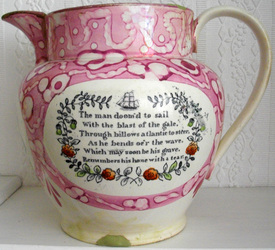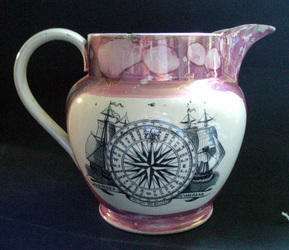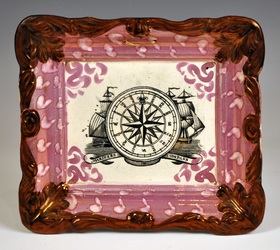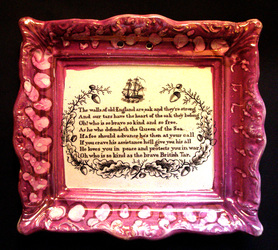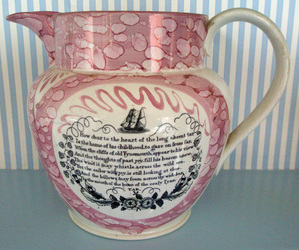|
8/31/2011 0 Comments High and Low Lights, North ShieldsFurther to my August 18th posting, Ian Holmes has been to North Shields with his camera. I wouldn't mind living in one of the lighthouses. The High Light looks to have been rebuilt in 1860, so postdates the structure shown on the jug. I guess that the Low Lights Tavern was where John Patton's ales and 'home-brew'd porter' were served. Perhaps in a Carr frog mug.
0 Comments
I was able to find a match for one of the bridge transfers (see my previous post) on a bowl with a 'SCOTT' impressed mark. Compare the transfers on the two items below, but remember that one of them has been applied to a curved surface. The bowl looks to have been made c1855 as it has Crimea transfers. I would guess the plaque is slightly later. Anyhow, the discovery hardly helps us, as I'd already attributed the plaque to Scott. The next two unmarked items share the same bridge transfer. It's very similar to the Scott version above, except that it is missing a row of small clouds on the horizon (note the blank space around the kiln smoke and the house to its right). At the time of writing, the jug is available on eBay (number 370531920569). The bowl is in the stock of Ian Sharp. So far I've found 8 variations of this transfer (the remainder are below), and I'm sure there are several more. Again, looking at the cloud formations is the easiest way to spot their differences. At the time of writing, the last jug is available on eBay (number 390336311785). It is probably Garrison (Dixon). Its other transfers are shown below. Now although none of the above helps us with the attribution of the bowl in the last post, it has been a bit of an eye opener for me. I would never have guessed there were so many variations of the same transfer in circulation. It makes attribution complicated to say the least.
8/21/2011 0 Comments Plaques with leaf-printed bordersThe top left plaque below came up at Keys recently. It is unusual in that it has a transfer-printed leaf border and is unlustred. I know of only three others – all shown below. All of them have transfers commonly associated with Sunderland (Wearside) potteries. However, the bowl below, from United Collections' new page has three of these transfers. We can be pretty sure the bowl is Tyneside because it has a London impressed mark. So are the leaf-bordered plaques Tyneside or Wearside? Below I've compared the transfer on the leaf-bordered Mariners' Compass with that on a similar Garrison Pottery (Dixon) plaque from Sunderland. Look at the waves in the second detail. The plaques are very clearly printed from different transfer plates. The Dixon version is titled 'Mariner's Compass' and the leaf-bordered plaque 'Mariners' Compass' – note the position of the apostrophe. To see how the leaf-bordered plaques compare with the bowl, we need to look more closely at their shared transfers. The bowl on the second row is the one discussed above. Looking at the details in the third column, it is clear they come from different transfer plates. Look at the sails of the ship on the horizon. Also, compare the profile of the edge of the sea, to the right of the canon. The third row shows the other bowl on the United Collections page with a London impressed mark. But interestingly, it also has a different version of the transfer. Note the shading of the grass in the right detail. The final two plaques are attributed to Scott of Southwick (Wearside, i.e. Sunderland). As you might expect, they come from the same transfer plate, but don't match any of the transfers above. So we now have four variations of the transfer. Nobody said this was going to be easy! My guess is that the penultimate plaque, attributed to Scott, is the oldest (c1845), so it seems likely that the other three transfers are copies. But we're still no closer to knowing where the leaf-bordered plaque comes from. The other transfer I want to look at is the west view of the bridge over the River Wear (transfer 31 in Baker). Some of the photos aren't great, but they serve their purpose. Note the formation of the clouds in the right detail. Yes, they all come from different transfer plates. Even the last two plaques, which are both attributed to Scott of Southwick. So it is still impossible from the evidence above to say whether the leaf-bordered plaques come from Tyneside or Wearside. Someone out there will have an item with an impressed mark with one of the above transfers. If so, please compare it with the details and let me know if you find an exact match. I just remembered a jug I have with the Mariners' Arms, and ran downstairs to find it. Unfortunately, we now have a fifth variation of that transfer! P.S.In case anyone was wondering, the 'Sailors Farewell' on the bowl (below left) is different to the version that appears on Dixon plaques (below right). Note the clouds and foliage again.
8/19/2011 0 Comments More on Tynemouth transfersOver the last year and a half, Ian Holmes has made many fantastic contributions to this site, which would be a much less interesting place without his input. I'm amazed by the breadth of his collection, which mingles the fine and rare, with quite humble objects like those below, which might escape the attention of other collectors. Click to enlarge. Take a look at the latest page of his website, United Collections, written in response to my recent posts on Tynemouth and North Shields. There's enough there to keep me thinking for weeks, trying to reassemble the pieces. And most excitingly, two bowls with London impressed marks.
8/18/2011 1 Comment North Shields Pottery partnershipsI am deeply indebted to Keith Bell for providing the following newspaper clippings. They resolve some of the question marks in R C Bell's chronology (as far as I know, Keith and R C aren't related). As a reminder, R C Bell's (Tyneside Pottery, 1971) dates for the early North Shields partnerships are as follows: Cornfoot, Colville & Co, 1829–c1832 Cornfoot, Patton & Co, c1832–1834 Cornfoot, Carr & Patton, 1834–1847 However, the first two newspaper clippings below suggest otherwise. According to them, the firm operated as Cornfoot, Carr & Co from 1832–1838. Assuming Bell's dates for the first partnership are correct, the pottery would have used the initials C. C. & Co from 1829–1838. The first announcement was put in the Northumberland Advertiser on March 13th, 1832. Published on February 24th, 1838, in the Newcastle Journal, a second announcement advises the public of the 'demise of Mr Cornfoot', and states that the firm will henceforth trade as Carr and Patton. R C Bell suggests 1847–1848 for that partnership. However, we can now adjust that to 1838–1848. This third advert from Fordyce's Maritime Survey of the River Tyne, published in 1846, announces that Carr and Patton are now trading at the Phoenix Pottery, Ouseburn, as well as North Shields. This is a year earlier than stated in Bell's chronology. The announcement also helps us to understand why Patton continued to mark his wares 'JP Newcastle & North Shields' after pulling out of the North Shields Pottery (see my August 4th, blog post): he also had a brewery in North Shields. So we can say now with a degree of certainty that the early North Shields partnerships were as follows: Cornfoot, Colville & Co, 1829–1832 Cornfoot, Carr & Co, 1832–1838 Carr & Patton,1838–1848 The final article, from the Shields Daily News, Saturday March 24th, 1894, shows that pottery making ceased at North Shields in 1893, and not 1900 as often quoted. An old North Shields industry, if not the oldest survivor of the many flourishing mercantile and manufacturing enterprises of North Shields, has been discontinued, and the final scene will be enacted when the plant will be dispersed under the hammer on the 30th instant. This will be an end to the manufacture of pottery in North Shields. But we are glad to know that the stock of pottery has been taken over by Mr King, a servant of Messrs John Carr & Sons, who will continue, in large show and warerooms, in part of the pottery premises, the sale of ware goods of all descriptions. It is a reassuring fact that Messrs Carr are continuing, and are making extensive and costly preparations for carrying on the manufacture of glazed bricks and other similar goods of a high class, and for which they have established a well deserved reputation. We wish them every success in this useful departure of manufacture, which is becoming more and more recognised and necessary to efficiently carry out really practical sanitation. This is one amongst many signs of success in the borough. It is natural to deplore the extinction of old industries, but when they are replaced by more extensive productions to keep pace with the march of progress, there is nothing to regret. It is a fact that more wages are earned in the borough than in what are designated as its “Palmy Days”, men are better employed, better paid and better housed than in the old days. The Low Lights Pottery has existed since the early years of the present century, and not only did a large business, but produced a style of manufactures which were a credit to the town and were deported to all parts of the known world. Many men who were engaged within its walls afterwards attained a great success and affluence in several walks of life and looked back to theLow Lights Pottery as the first rung in the ladder of their ascent. About forty years ago there were not less than twenty potteries on the Tyne and Wear. Now there are not more than half a dozen. The wedge like plot of ground occupied by Messrs Carr has had many viscissitudes. There existed a glass works in the misty past – there the original gas works were planted. There Messrs Tyzack and partners had their chain works and test, afterwards occupied by a shipbuilding firm. We cannot leave this interesting item in the history of old Shields without referring to the head of the firm, the late Mr John Carr, who, in addition to carrying on successfully several businesses, reared many sons who became expert businessmen and he also did the State some service in public life. Moreover he was a genial and large-hearted citizen. Keith stumbled on the articles above while doing some family research, and they inspired him to write a page on the North Shields Pottery on Wikipedia. Imagine what a clear picture we'd have of the subject if everyone was as generous in sharing their findings. When one generation of collectors dies, they take their knowledge and experience with them, and the next generation has to start all over again. If you can add anything, please get in touch. 8/18/2011 0 Comments High and Low Lights, North ShieldsThanks to Ian Holmes for sending photos of a jug attributed to John Carr. It has the verse transfer on the plaque in my Aug 3rd posting. It also has a transfer titled 'Shields the mouth of River Tyne', showing the High and Low Lights, North Shields. (Click on images to enlarge.) Now, here I have to confess to having never visited North Shields. So it came as a revelation to me that the name of John Carr's 'Low Lights' Pottery, refers to the lower of two lighthouses, built in 1802, just inside the mouth of the Tyne. (Again, click on the details below to enlarge.) In the detail of the transfer, note the two kilns to the right of the lower lighthouse. The right photo, taken from Google, shows the view from a similar perspective today. For interest, here's the transfer on Ian Sharpe's jug, showing the view from South Shields, down river towards Tynemouth (see my August 3rd posting). The High and Low Lights are concealed from view behind the cliffs on the left (Ian Holmes drew me an excellent map). The buildings on the left of the cliff top seem to relate to Tynemouth Castle or Priory (not kilns as first supposed). The large ruin in the centre is Tynemouth Priory. The tower on the right was used as a lighthouse until the new St Mary's lighthouse was built in 1898. The bottom right photo (lifted from Sabre) is roughly from the same place. The building on the right is a modern coastgaurd centre. In the August 3rd post I showed photos of the base of a bachelor set with the Tynemouth Haven transfer, and a 'C. C. & Co' printed mark. Ian Sharp thought that the item looked c1840, whereas the Cornfoot, Colville and Co partnership ended sometime c1832. I queried why one of the later partnerships would use the C. C. & Co mark. Thanks to Keith Bell for getting in touch with what looks like the answer...
I have found an advertisement which was carried in the Northumberland Advertiser of 13th March 1832, headed 'North Shields Pottery' and going on to inform the public that the North Shields Earthenware Manufactory is now carried on under the name of "Cornfoot, Carr and Co." and continuing "C.C. & Co. take this opportunity of announcing....." So the C. C. & Co mark appears to have been used beyond 1832 and perhaps into the 1840s. This has implications for the circular plaques with the impressed C. C. & Co mark. Perhaps some of them were produced later than is generally supposed. Below are photos of other verse plaques from the same series as the 'Prepare' in my previous blog post. The 'Thou God' appears on small rectangular plaques (180 mm x 140 mm) with a moulded flower in each corner. The circular plaque below once had a red and green border, but the green has worn away. This first row of plaques are likely c 1830s–1840s. The second row of plaques are attributed to Carr (c1850s–1870s). The 'Rejoice' transfer appears on the same early plaque forms. However, I've never seen one on the smaller Carr-attributed plaque form (like the bottom left above; group 2 in my July 30th blog post). The other verses on that plaque form are relatively common, so if a 'Rejoice' had been made in similar quantities, I'd certainly know about it. Perhaps a 'Rejoice' transfer plate was never made with 'twiddly bits' in each corner. 'God is Love' appears on all of the rectangular plaque forms, including the form similar to Maling (top right). I haven't yet seen a circular one, but I'm sure there must be one out there. N.B. the earlier plaques are rarer, and I've only ever seen one circular 'Rejoice'. The bottom centre plaque has a rare cobalt blue transfer. More on that below. Cobalt blue transfers on plaques are exceptionally rare. These are the only three I know of, and they are all on the smaller 'group 2' plaques attributed to John Carr. Interestingly, none of these plaques has a transfer that appears on the larger Carr-attributed plaques. The last few weeks' blog posts are the sum of my knowledge on John Carr. Perhaps you have a missing part of the puzzle: a jug with one of the transfers above, another plaque with a Carr impress, blue transfer or a London impressed mark? If so, please share!
I should have written this blog post months ago when I was sorting through the various 'Prepare' transfers. Below is a variety of plaques, about half of which I've attributed to Carr. The transfers in the second row have an obvious difference. In each corner there are twiddly bits (excuse me if I'm becoming too technical) to fill the rectangular frame. The left detail below is from row 1, the right detail from row 2 with the added twiddles. Another difference is that on the first and third rows, the letters of the words 'PREPARE' and 'GOD' are studded with rows of white pips. Below is a series of details, respective to the plaques above. So the twiddly bits in the corners weren't just added on. The transfers come from two separate copper plates. N.B. I've looked long and hard at the details on the first and third row, and they appear to come from the same plate. So who made the plaques? The bottom left plaque is the fly in the ointment. Maling used this plaque form from 1830s–1850s. It also appears with the printed mark B & Co, which Ian Sharp has identified as J Burn & Co from the Stepney Bank Pottery, Ouseburn, 1852–1860. Before remembering this plaque, I would have happily attributed the first row of plaques to Cornfoot, Carr & Patton, 1834–1847. But because we've no reason to believe the bottom left plaque is Carr, we've no reason to believe the first row of earlier plaques are Carr either. Incidentally, the first and third of the circular plaques are very chunky. Some of the Maling circular plaques are very thick too. And note that Maling also decorated their wares in green. But all of this is too tenuous to form the basis of a solid attribution. The second row of plaques seem likely to be Carr. N.B. these plaques appear with the 'LONDON' impressed mark. Of the list of potteries that used the London mark, Carr seems the obvious choice. In my July 31st blog post, I established a link between this 'group 2' plaque form and the larger plaques commonly attributed to Carr. So perhaps sometime around the 1860s Carr bought the transfer plate from the pottery that made the bottom left plaque, and used it to make the last two plaques. You can see now why I've put off writing this post so long. Clear as mud! P.S.The distinctive decoration of the plaque below (courtesy Adrian Harding) may one day help us identify the mystery pottery.
In my July 31st posting I said that as well as running the Low Lights Pottery, North Shields, "Carr & Patton also took over the Phoenix Pottery, Ouseburn, in 1847. Bell writes that their partnership was apparently dissolved a year later, with John Carr continuing at the Low Lights Pottery and John Patton at the Phoenix Pottery. Separating their wares of the 1850s might be difficult." The next day Ian Holmes reminded me of a jug he purchased last year. It has a mariner's compass transfer signed 'J P. Newcastle and North Shields' (see below left detail). Ian Sharp has a jug with a very similar mariner's compass transfer on his website, but it is signed 'J C. Co N Shields' (see below right). The '&' appears to be obscured by a break in the transfer. It seems clear enough that the right detail refers to the John Carr & Co partnership of c1850–1854. The left detail is more confusing. It must have been engraved after 1848 when the Carr and Patton partnership dissolved (or else why aren't both sets of initials on the transfer?) and John Patton took over the Phoenix Pottery, Ouseburn (Newcastle). But it suggests he still had some stake at the Low Lights Pottery in North Shields after that date. Perhaps with the Phoenix Pottery being a new venture for John Patton, he simply wanted to make clear he was the same J P who'd worked in North Shields for 15 or so years. Now here's the exciting bit. The John Patton jug has one of the ship transfers that appear on the bowl in my July 20th blog post. So it now seems more likely that the bowl is Patton than Carr. This would explain why the third ship transfer on the bowl doesn't match those on the plaques attributed to Carr. The jug unites a transfer from the plaques in group 1, in my July 30th blog post, with a verse transfer that appears on plaques similar to those in group 2. The dimensions of the verse plaque are 210 x 185 mm which is slightly bigger (5mm) than the group 2 average. So if the plaques were made before 1848 they are Carr & Patton. If they were made after, they could either be John Carr's Lowlights Pottery, North Shields or John Patton's Phoenix Pottery Ouseburn. N.B. it wouldn't be surprising if J C and J P continued to decorate their wares in very similar ways. For what it is worth, I think the verse plaque was made by J P. But there's still a reasonable chance the ship was made by J C. For completeness, here are the images of Ian Sharp's jug, with John Carr's initials. This verse transfer doesn't particularly help our cause, as to my knowledge it never appears on plaques. And finally, for anyone who thought this was going too well, take a look at the mariner's compass transfer that appears on plaques attributed to John Carr (click to enlarge). Though clearly based on the same source, the transfer is simpler in design and both the plaques below have the initials J H at the bottom. If you can tell me why, please get in touch! P.S.One obvious difference between the two transfers above is that the larger plaque on the right, whose detail is shown in the centre, has shading over the initials J H. Perhaps Carr acquired the transfer plate from another pottery, and had it re-engraved to obliterate, or at least reduce the prominence of, the initials.
8/3/2011 1 Comment Tynemouth HavenThanks to Ian Sharp for providing this piece of the puzzle. Ian is one of the few specialist UK dealers of 'Sunderland' lustreware. He has years of experience of attributing lustre items. You can visit his new-look website by clicking here. I've established a link between Carr and the plaques in group 2 of my July 30th posting, but what about the plaques in group 1? Below is a rare verse plaque from group 1. It has the distinctive, almost stripy looking pink lustre decoration. Ian attributes the plaque to Carr on the basis of the transfer's pairing with a view of Tynemouth Haven on the jug below (you can find a similar jug in Ian's stock on his website, dated 1844). For those who aren't familiar with Tyneside geography, Tynemouth is just beside North Shields, where John Carr's Pottery was located. Ian writes 'I think it makes sense that a pottery in North Shields would use a transfer of North Shields with the kiln clearly shown.' The other verse on the jug (below right) has a line mentioning 'the cliffs of old Tynemouth'. (Click on the images to enlarge.) In case you needed more convincing of the attribution, Ian provided this photo of the base of a 'bachelor set'. It has the same transfer of Tynemouth Haven, this time paired with a Charles Wesley verse. On the underside there is a C, C & Co printed mark (the first 'C' hasn't printed well). So the bachelor set was made by Cornfoot, Colville & Co sometime between 1829 and c1832. The jug was likely made by Cornfoot, Carr & Patton, sometime c1844. And my hunch is the plaque was made sometime after that, by one of the later Carr partnerships. We may never know which! But at last a positive ID for a plaque from group 1. P.S.Ian has been in touch to say that he would date the bachelor set as later, c1840. This would mean that either: Cornfoot, Carr & Patton used a C, C & Co printed mark; or that Bell's dates for those partnerships are inaccurate. I'm keeping an open mind.
|
AuthorStephen Smith lives in London, and is always happy to hear from other collectors. If you have an interesting collection of plaques, and are based in the UK, he will photograph them for you. Free advice given regarding selling and dispersal of a collection, or to those wishing to start one. Just get in touch... Archives
February 2022
AcknowledgementsThis website is indebted to collectors, dealers and enthusiasts who have shared their knowledge or photos. In particular: Ian Holmes, Stephen Duckworth, Dick Henrywood, Norman Lowe, Keith Lovell, Donald H Ryan, Harold Crowder, Jack and Joyce Cockerill, Myrna Schkolne, Elinor Penna, Ian Sharp, Shauna Gregg at the Sunderland Museum, Keith Bell, Martyn Edgell, and Liz Denton.
|



